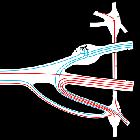conjoined nerve root
A conjoined root is a type of developmental anomaly involving a nerve root. It is the most common nerve root developmental anomaly of the cauda equina being twice as common as two roots in the same foramen, the next most common anomaly.
Epidemiology
The incidence in cadaveric studies is ~10 (range 8-14)% . In a recent prospective MRI study, it was 6% . In retrospective studies, the reported incidence is much lower.
Clinical presentation
There seems to be an association with vertebral malformations ; the latter may cause low back pain. The nerve root anomaly may be asymptomatic or cause spontaneous pain (i.e. sciatica) .
Gross anatomy
The term "conjoined nerve root" actually refers to the roots of two adjacent segments, arising at the same level from the thecal sac, enveloped by a common root sleeve. The affected neural exit foramina may be empty or sometimes contain an additional nerve root .
Location
The L5 and S1 segments are most frequently involved.
Associations
Vertebral anomalies , such as:
- vertebral arch defects
- spondylolisthesis
- spina bifida
- absence of the ipsilateral facet joints
Radiographic features
Conventional x-ray myelography, CT myelography and MRI can be used to demonstrate this anomaly. Coronal T2WI and x-ray myelography have been shown to have equal sensitivity with MRI considered the gold standard. CT myelography is useful in indeterminate cases .
Plain radiograph
- may show associated vertebral anomalies or malformations
CT
- may show the anomaly but will often fail to do so if the scan is confined to the intervertebral disc spaces
- CT myelography will also demonstrate the anomaly
MRI
The most accurate non-invasive imaging study . Axial slices should be continuous over several segments, and coronal slices should be included. Typical signs include :
- corner sign: asymmetry of the anterolateral corners of the dural sac
- fat crescent sign: extradural fat between the asymmetric dura and the conjoined nerve root sleeve
- parallel sign: visualization of the parallel course of the entire affected nerve root at the disc level
Differential diagnosis
Imaging differential considerations include:
- disc herniation
- post-arachnoiditis adhesions of the cauda equina
- other congenital root anomalies
Siehe auch:
- Spina bifida
- Spondylolisthesis
- Spinalnerv
- anomalies and malformations of spinal nerve roots
- absence of the facet joints
- vertebral arch defects
und weiter:

 Assoziationen und Differentialdiagnosen zu conjoined nerve root:
Assoziationen und Differentialdiagnosen zu conjoined nerve root:


